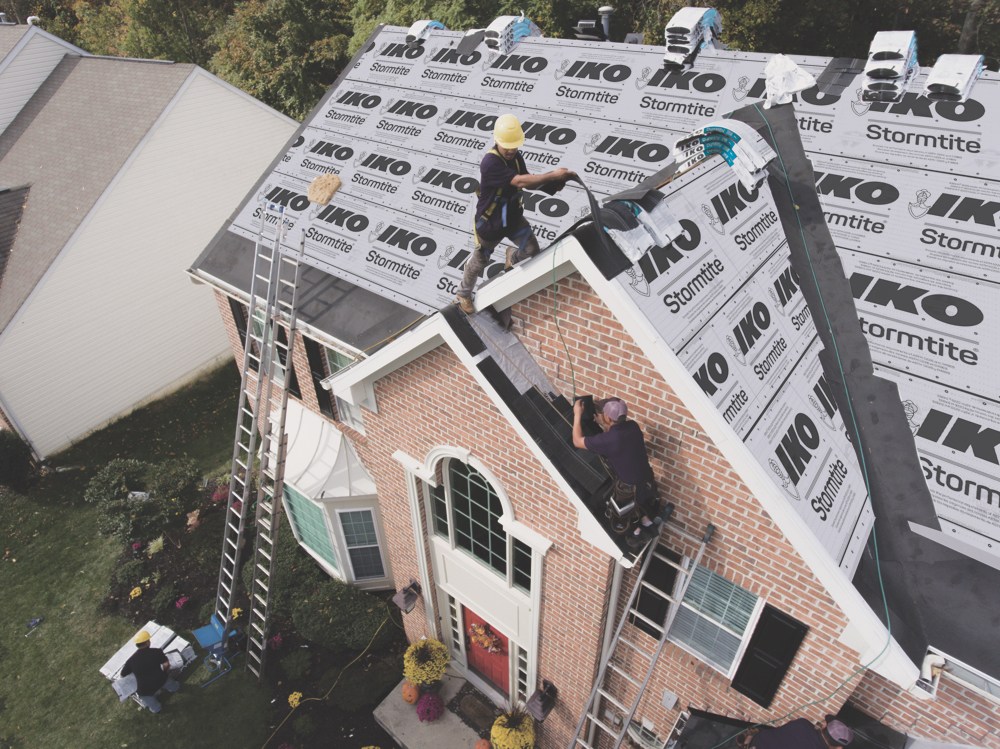SWOT Analysis for Roofers
Table of Contents
- The SWOT Framework
- S for Strengths
- W for Weaknesses
- O for Opportunities
- T for Threats
- Sample of a Roofing Business SWOT
- Compare Your Weaknesses to Your Competition’s Weaknesses
- More Targeted SWOT Analysis Strategies for New Businesses
- How to Do a Better SWOT Analysis as a Small or Medium-Sized Enterprise
- Using the SMART Framework with a SWOT Analysis
- Limitations of the SWOT Analysis
SWOT analyses have long been a useful tool for businesses of all kinds. A complete SWOT analysis can inform your long-term business strategy, helping you make up for your major weaknesses and use your strengths to capitalize on opportunities. It’s a simple method to use and understand, and even new business owners can find value in it.

However, advice about the framework is so general that you may struggle to see how it could apply to your roofing business specifically. To help you out, we’ll break down how the method can be employed for roofing businesses to give you a clearer view of what a SWOT analysis might look like for your company. We’ll also share tips on how to do a better SWOT analysis as a small or medium-sized business and talk about the limitations of the method while giving potential solutions about how you might be able to make up for them.
The SWOT Framework
During a SWOT analysis, you identify the strengths, weaknesses, opportunities and threats that affect your business. This analysis can be useful to help your business improve, grow, leverage its strengths, and reduce the threats it faces. Doing SWOT analyses on a regular basis can help you see problems coming and give you an opportunity to address them so that you can prevent them from becoming weaknesses in the first place.
For example, if you’re a roofing company doing a SWOT analysis, and a new competitor poses a threat, you can find out what that business may be offering that you don’t, to understand if they really are a threat and to prevent this potential threat from becoming a weakness.
Let’s say that the new business is offering gutter cleaning, a service you don’t currently offer because you find that these calls aren’t profitable enough. You can choose to offer to clean gutters in a way that makes sense for your business to prevent loss of customers, or you might offer gutter cleaning only for customers that have a maintenance plan with you, or for free with a new roof or roof repair. That way, you can keep customers who need this service, without incurring the cost of doing calls that are just for gutter cleaning service, and losing money.
If you didn’t address the gap between what you offer and what your competitor offers, you may do another SWOT analysis a year or two later and find that the threat of a new competitor has become a weakness because it resulted in fewer customers for you. You can fix this issue, but you’ve already lost out on money missing out on customers. Plus, the new competitor will have built a reputation as the roofing company to choose from if you need gutter cleaning. It will be harder to regain lost ground. Regular SWOT analyses will help you see these issues coming, so your business can better plan ahead.
It all starts with a thorough analysis. Performing the analysis is simple. You work through each of the four items and write down a short summary. It may be useful to go into more detail later, but, at the start, keep each item brief so that you can see a quick overview of your business. This will help you pull on general trends. Of course, when possible, include small stats that help you quantify each item. Don’t just write ‘high customer satisfaction’ and, when you can, include an exact percentage point.
Here’s more information on each step of the SWOT process for roofing businesses specifically.
S for Strengths
Strengths and weaknesses are both internal factors. Your strengths are the aspects of your work that you know that your business does well or advantages that you believe you have. As a roofing company, one of your strengths might be how thorough your roof inspections are. You catch problems with the roof that some would overlook, you don’t have to change your quote price later on, as your competition might. Or, it may be the responsiveness of your team to emergency calls from customers, who appreciate the peace of mind. Alternatively, you may find that your strength is in your service area, where you have access to a lot of potentially high-paying customers, so long as you can convert them.
W for Weaknesses
Next you should list out your weaknesses as a business. Weaknesses are internal factors and sometimes external factors (although, these are more likely to be threats). They are areas where you know your business could improve. You may find that your pricing strategy is a weakness, causing you to estimate too low. Or, you could find that your training of your employees is a weakness, as they are not all consistently aware of your business practices, and few would be ready to take on a leadership role if you had an opportunity to expand the business.
It can be hard to generate strengths and weaknesses on your own. So, here is a list of internal parts of your business that you might consider as a strength or as a weakness:
- Customer service.
- Shingle features and quality.
- Sales strategy.
- Marketing strategy.
- Employees.
- Training.
- Safety practices.
- Customer loyalty.
- Pricing.
- Cash flow.
- Leadership and management.
- Insurance coverage.
Try to be as specific as possible with your weaknesses so that your solutions can be targeted. For example, if you know that your chimney flashing installation could improve, it is more useful to list the reason why than just the problem. You may need to enhance your training or invest in better tools. By being specific, you make your solution more obvious. Now you know that you should discover which individual employees need better training or which tools you need to invest in to improve your installations overall.
Make sure that you write out your strengths and weaknesses as specifically as possible, instead of just thinking about them, so that you can use them in the next steps and make a plan to leverage or address them.
O for Opportunities
Opportunities are external factors that may benefit the company. There are two general possibilities for your opportunity. Either you need to create a plan to take advantage of them, or they offer inherent opportunities without you needing to do anything. For example, if your competitor is not spending a lot on advertising to generate roofing leads, you could capitalize on that by boosting your spending. Specifically, look at the exact channels your competition uses. If they haven’t invested in pay per click advertising (PPC) or in social media, you have more opportunity on those channels to out-compete them.
On the other hand, your competitor goes out of business altogether, then you’re likely to see some inherent benefit without taking action (although you could get even more benefit if you did take action to target the customers that are no longer being served).
While opportunities are typically things happening outside of the business, they can occasionally be internal as well. For example, a new staff member with special skills may help you better meet customer needs, so long as you position them to offer those skills to your customers.
T for Threats
Threats are also external factors, but those that have the potential to damage your business. For example, if people are moving out of your area, and immigration to your area is also down, you may struggle to fill your open positions with the local workforce. Knowing this threat can help you make better hiring decisions earlier on, when they can have more impact. You could add staff before things get too dire or start looking for ways to attract employees that are willing to relocate.
Threats don’t have to be specific to your local area. You may face a more general threat, like an economic downturn that reduces the number of people who are willing to spend on roofing. Or it may reduce the amount of people who are willing to buy more expensive shingles and accessories when they do get a roof replacement. Threats may occasionally be internal. For example, an employee who is cavalier about wearing their fall protection harness may be a threat to the business not just by increasing their personal risk but also by impacting how customers perceive your business and incurring OSHA violations and penalties. The staff members’ attitude may seem careless and unprofessional, which will impact your brand and may end up costing you money in fines.
Here are some external items you might consider opportunities or weaknesses:
- The overall economy.
- Prospects of the construction sector.
- Consumer trends in roofing.
- Commercial trends in roofing.
- Labor availability.
- Competition’s strengths.
- Competition’s marketing strategy.
- Market share.
- Availability of materials.
- Delivery of materials.
- New legislation or building codes.
- Drone technology.
- Other roofing technological advancements.
When examining your threats, be sure to consider Porter’s five forces, a concept discussed in an essay published by Harvard Business Review Competition in any industry, including roofing, is not just about who customers choose or when new businesses enter the market (force one and two). You also need to consider the bargaining power of your buyers (force two) which, in roofing, might be a major customer like a developer or just a homeowner. Then there is the bargaining power of your suppliers (force three). All of these elements will help you get a total picture of existing competition in the market (force five).
For example, if one of your buyers is a larger business than you, then they have high bargaining power. It is inexpensive for them to choose a new roofing company. A classic example is a new developer, who has a whole neighborhood of roofs to put up, and multiple local businesses to choose from. This makes your business less stable than a roofer who services only small homeowners.
Supplier power also matters in a market. In the roofing industry, you have many choices of supplier, which means that suppliers have less leverage over you and are less likely to raise prices considerably and reduce profitability. However, if you only have access to one or two roofing suppliers, it is harder to switch between them, and your business may be under more stress.
Sample of a Roofing Business SWOT
|
Strengths
|
Weaknesses
|
|
Opportunities
|
Threats
|
Once you have assessed all four of the SWOT items, it can be useful to see how they might work together or contradict. Will a strength help you overcome a threat? Is a weakness preventing you from maximizing an opportunity? Overall patterns can be more fruitful than focusing on any one item.

For our sample business, we can see that their major threat is a new competitor, targeting the same customers. They could use their superior sales strategy to out-compete the newcomers. Or, they could see that several of their strengths lend towards targeting a new, higher-end market. With quality work, an association with a manufacturer, and a strong sales strategy, they could pivot to get new customers. This could also help them resolve a major weakness that their current customers delay payments. Targeting a higher-end market could also help them take advantage of the consumer trend towards buying performance shingles.
Our sample business also has a few items that relate to labor availability. As with many roofing companies, they struggle to find candidates interested in their roofing positions. This hiring trouble may help explain the current staff’s lack of experience and why they don’t estimate enough materials for some jobs (which wastes time). However, under opportunities, we can see that this business also invests in new training. Perhaps they could better target their training to bring their staff up to scruff with the basics, instead of investing in more advanced topics, such as algae remediation. Or, the company could invest more in drone technology, potentially so that they can make up for a lack of employees.
As you can see, SWOT analyses do not necessarily give you a certain path forward. Instead, they help you start thinking and strategizing about the key issues that are before your business. Your plan is still up to you.
Compare Your Weaknesses to Your Competition’s Weaknesses
Taking a big-picture view of all four elements of the SWOT analysis is important, but it is especially true of weaknesses. If all your competitors share a weakness, there may be a reason for it, and you may not be successful making up for the weakness. Instead, you may be wasting resources. For example, a business insurance professional may tell you that your insurance coverage of two million is low, and that contracting businesses of your size have 5 million in coverage. But, if your direct competition, other roofers, all have what the insurance company considers low coverage, there may be a reason for that. Referring to multiple experts in roofing insurance may help you decide which is best for your business. The same goes for problems in other areas.
Solutions to your weaknesses may also be more complex than you imagine, based on what the other roofing contractors are doing. For example, if your profit margin is very thin, but so is every other roofing business in the area, trying to address this by raising prices may force you out of the market. On the other hand, if you can justify these higher prices, typically by offering a better service, better roofing products or customer experience, then you may be able to increase your profit margin and get a leg up on the competition. As with all business, nothing is guaranteed.
More Targeted SWOT Analysis Strategies for New Businesses
New businesses have many challenges. One of the biggest is getting a sense of the market that they are stepping into. As a new business owner, you need to understand the pressures and competition in the environment. The external factors of a SWOT analysis will help you get a quick idea of how the market is doing, and therefore how your business can fit in or break the mold.
Another major challenge when opening a new roofing business is seeing how reality matches your predictions. This is especially true of internal factors. You may believe that offering gutter cleaning will bring in customers, or that your decision to use a virtual receptionist will make sense, but reality may be completely different. The sooner you can get a handle on your real weaknesses and strengths, the better you can grow your business. For example, if the basic marketing strategies you started with, such as vehicle wraps and lawn signs, aren’t working, it’s important to find that out while you still have runway to change your strategy.
Once you start to take on projects, you may find that you’re not sure if they’ll be profitable. Until you have more experience, it can be helpful to perform a SWOT analysis for each job you consider.
How to Do a Better SWOT Analysis as a Small or Medium-Sized Enterprise
Small and medium-sized roofing businesses have more challenges when completing a SWOT analysis. You have fewer expert staff who can help you assess your own company and the external factors that might affect it. You also typically have less access to market research, competitor research, and outside analysis that might help confirm or contradict what you feel about your business.

Questions that might help you identify your SWOT items as a small or medium-sized roofing business include:
|
Strengths
|
Weaknesses
|
|
Opportunities
|
Threats
|
Once you have identified your SWOT, you can look at the combinations in unique ways. Any areas where weaknesses and threats align are especially troubling. For example, if your competition is investing in installing solar roof vents, and your market is increasing in demand for greener technology, this could be a concern. On the other hand, strengths and opportunities that align are especially beneficial. If your strengths are quick installation and connections with builders, and there is a lot of new construction in your area, you may be able to take advantage of it.
While you may not have many experts or other authorities at your business, distributing the SWOT analysis to staff can be helpful. Ask them if they agree with your assessment of the items on your list, especially the ranking. Those who have a different view of your business may give you a lot of insight.
In the end, you will likely want to generate a way to address all of the significant SWOT items you identified, including how to maximize strengths, work on weaknesses, take advantage of opportunities and minimize threats. For small business owners, a good framework to use to make these plans is the SMART framework.
Using the SMART Framework with a SWOT Analysis
SMART stands for:
- Specific: Write down your exact goal to make sure it is clear. For example, you may want more complete roof replacement work.
- Measurable: You need to figure out how many roof replacements you do now and set a goal for how many you’d like to do. For example, you would like to do 20 more roof replacement jobs this season.
- Attainable: Your goal shouldn’t be so high that it is overwhelming. There is a possibility you could do this many roof replacements in your market, and you know how you could achieve that goal. For example, you will add new marketing efforts to target those who need to replace their whole roof.
- Relevant: Be sure that this goal is beneficial for you. For example, you know that roof replacement work is more profitable for you than repair work.
- Time-based: Adding a timeline to your goal will help you achieve it. For example, you want to do 20 more roof replacement jobs over the next six months. Then, 20 more roof replacement jobs in the quarter after that.
While a SWOT analysis and SMART goals are useful tools for small roofing businesses, they have limitations. It is essential to understand those limitations before you finish the analysis.
Limitations of the SWOT Analysis
We often base SWOT analysis items on our perceptions about our roofing business instead of the facts of our business. You may end up confirming your biases when you complete a SWOT analysis, and that can be a bad thing if you’re mistaken. So, you should attempt to confirm your hunches when you can. For internal strengths and weaknesses, this is relatively simple. If you’re concerned that your staff doesn’t have adequate training, you can test them to make sure before you invest in new training. If you think you don’t do enough installations of designer shingles, you can look through your records to see how much you’ve done.
However, testing external opportunities and threats can be more challenging. Research from third parties, competitor analyses, and other concrete data can help you understand these external factors better and make a SWOT analysis more useful.
Critics also argue that the SWOT analysis does not help you prioritize all the factors you have listed out. So, you may not know which of your threats you should address first. You may also not know which of your strengths is contributing the most to your success. When you can, you should try to prioritize the items on each list. Ideally, you’d use data to back-up your priorities. However, you’ll typically be relying on your intuition as well.
Lastly, a SWOT analysis is not meant to be a one-time tool. You should come back to the analysis if you find it useful, once a year or whenever there is a significant change in your business or the business environment.
Are you looking for more resources to help you leverage a SWOT item, or to make your roofing business more successful? Check out IKO’s resource for roofers to get more useful information.




